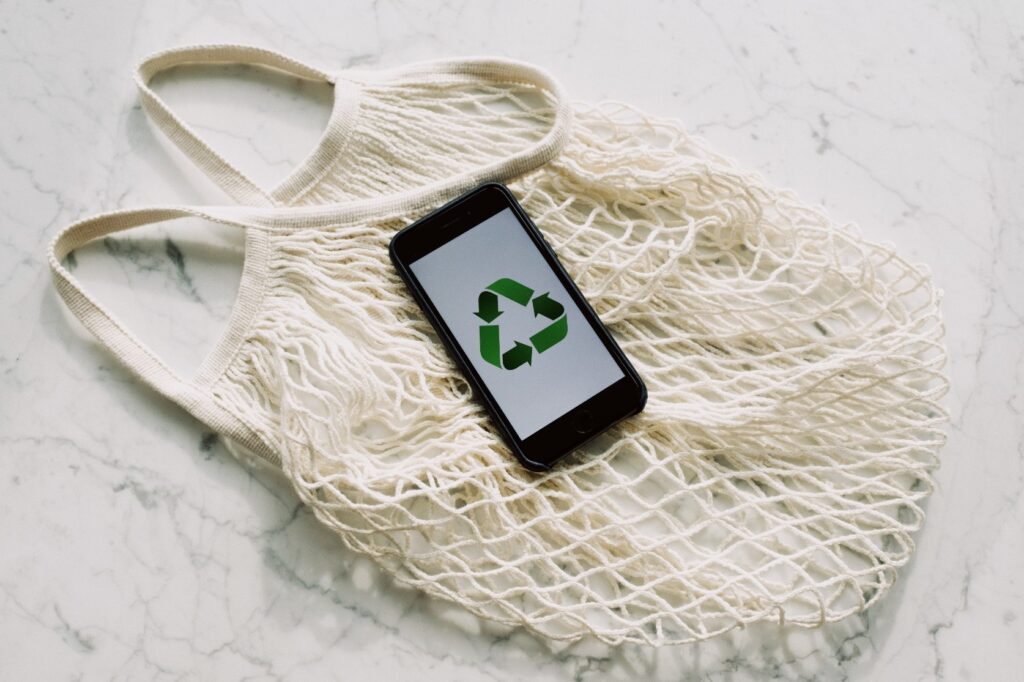
Recycling and reusing are two of the most important ways to reduce waste and conserve natural resources. Recycling is the process of breaking down unwanted items and turning them into something new. Reusing means using an item for its original purpose or giving it a new purpose.
Both practices can help save the environment and reduce pollution. In this blog, we will discuss what recycling and reusing mean, what is the difference between reusing and recycling, why reusing is better than recycling, and tips on how to participate in each.
Recycling and reusing materials are one of the most important components of sustainability
What do you mean by recycling and reuse?
The term ‘recycle’ means to break down a product into its raw materials and use them to create a new product. Examples of items that can be recycled include plastic bottles, aluminum cans, cardboard, and glass. The process of recycling involves separating the materials and using them to make something new.
The term ‘reuse’ means to use an item in its original form or for a different purpose. Examples of items that can be reused include furniture, clothing, and glass jars. Reusing a product can help extend its life, reduce waste, and save money. Another benefit of recycling is that it can satisfy our need for new products.
There are many ways to reduce the need for the original item, including looking for alternative sources for the same items, searching for used items, and exploring the idea of renting items instead of buying them.
For example, if you need a laptop for work, instead of buying a new one, you can look for a used laptop or even rent one for a short period. This not only reduces the need for a new laptop, but it also reduces your financial burden.

What is the Difference Between Reusing and Recycling and reducing?
- The main difference between recycling and reusing is that recycling requires energy and materials to break down the items while reusing does not. Reducing, on the other hand, means buying less and throwing away less. This is the most effective way to reduce waste and conserve natural resources.
- Recycling and reusing raw materials is an effective way of reducing waste and preserving natural resources. By recycling materials, we can significantly reduce the number of materials being thrown away. Recycling means that instead of throwing away items, they are reused and repurposed for another use.
Upcycling is a way of reusing materials for another purpose to create a product of higher value. Upcycling is very sustainable because it does not require new raw materials to make new products. Instead, it uses existing materials to create something of a higher value. Not only does upcycling reduce the amount of waste being produced, but it also helps to reduce the waste of other raw materials.
An additional benefit of upcycling or reusing goods is that it can create products with new purposes. Upcycling and reusing allow us to make new products from existing materials, thus reducing the need for new raw materials.
3. This is especially important for items that have very long production cycles. By upcycling or reusing, we can reduce the number of resources needed for production, thus making new products more sustainable.
4. Reusing and upcycling are both great ways of reducing waste and preserving natural resources. Reusing items can extend the lifespan of items and upcycling can create products with new purposes.
5. Both of these methods of recycling can help to reduce the number of materials being thrown away, thus reducing our environmental impact.
6. Furthermore, reusing and upcycling are both very sustainable and can help to reduce the number of resources needed for production.

What is the difference between reuse and recycling for kids?
The difference between reuse and recycling for kids is that when reusing, they can use the item for its original purpose, or give it a new purpose. When recycling, they must break down the item into its raw materials and use them to make something new.
When it comes to our consumption habits, one of the most important ways to make a difference is to recycle and reuse raw materials and natural resources. You might be surprised at the number of new items you can create, without having to buy anything new. Upcycling is a great way to have fun and get creative while still saving money. So why not give it a try?
The need to reduce our carbon footprint and reduce the amount of waste going into landfills has become a priority for many businesses and individuals alike. As a result, one of the best ways to do this is to invest in products made from recycled materials.
Energy consulting can often be a great way to save money and reduce energy costs. It is an area often overlooked and can often get intertwined with other energy initiatives. However, it is an important part of the bigger picture when it comes to reducing one’s environmental impact.
Recycling can still be improved upon, however. Reuse vs recycle is an important question when it comes to sustainable living. Reusing products and materials can help reduce the amount of waste that is generated and can also help to extend the life of items. Products made from recycled materials are often of higher quality and can often last longer than their traditional counterparts.
There are many benefits to recycling and reusing materials. Recycling reduces the amount of waste and helps preserve natural resources. Purchasing products made from recycled materials is also a great way to support sustainable manufacturing practices.
Recycling and reusing raw materials and natural resources is an environmentally friendly and sustainable way to reduce waste and conserve our planet’s precious resources. In the past, recycled materials were limited to simple items such as paper, cardboard, and glass.

Why is reusing better than recycling?
Reusing is better than recycling because it uses less energy and materials than the process of recycling. It also prevents the item from being sent to a landfill or discarded. When an item is reused, it can be used for its original purpose or given a new purpose. This helps to keep the item out of the traditional waste disposal system and can save money.
Recycling and reusing materials is an essential part of creating a sustainable future. By reusing raw materials and reducing the number of natural resources we consume, we can reduce the energy consumption of producing new materials.
So, what’s the difference between recycling and reusing? When you recycle something, you’re sending it to a facility where it will be broken down into new materials. When you reuse something, you’re using it again without needing extra processing. Recycling also helps to create eco-friendly materials that can be used in a variety of ways.
As the world population grows, so too does the amount of waste material that is produced. Waste management is essential to protect the environment and reduce the amount of waste that is produced.
One way to reduce the need for waste management is to make use of recycled materials instead of throwing away much waste. This not only reduces the number of waste that is produced but also lowers the number of harmful effluents that are released into the environment.
Recycled materials can be used in a variety of ways, including for packaging, construction, and even for clothing. This type of sustainable process can help reduce the number of waste that is thrown away, which in turn helps to reduce the number of harmful effluents released into the environment.
Using recycled materials for packaging can also help reduce the amount of waste that is thrown away, which helps to create a more sustainable environment.

Can Recycling and Reusing Go Together?
Yes, recycling and reusing can go together. Recycling is a great way to reduce waste and conserve natural resources. However, it also consumes energy and materials. Reusing is a great way to extend the product’s life and reduce the amount of energy and materials needed to create a new product. By combining both practices, we can reduce the amount of waste and conserve natural resources.
When it comes to sustainability and reducing our environmental impact, Original USA has been a leader in the industry for years. From the production of solar panels and other renewable energy technologies to the manufacture of eco-friendly products and materials, the Original USA is committed to reducing pollution and promoting sustainability.
Despite the efforts of the Original USA, much of the global population still relies on old, inefficient products that are producing more pollution than ever before. This old product is also reduced the overall lifespan of the products, leading to more waste and less sustainability. By creating products with longer lifespans, the Original USA is helping to less pollution and create a more sustainable future.
Why Are Recycling and Reusing Both Important?
Both recycling and reusing are important because they help to reduce waste and conserve natural resources. When an item is recycled, energy is needed to break it down into its raw materials and make something new. When an item is reused, energy and materials are not needed to create a new product. This helps to reduce the need for energy and materials and conserves natural resources.
Are you looking for ways to reduce your environmental impact? Recycling can be an easy and effective way to do so. Recycling bins are a familiar sight in homes, offices, and public spaces. But what about the items that can’t be put in a regular recycling bin? It’s time to look at the different ways to recycle items that don’t have a recycling symbol.
Reusing, repurposing, and upcycling are all forms of reusing items. Reusing means using an item in its current form. This means you don’t need to dismantle or upgrade the item to be able to use it differently.
Repurposing is when an item is used to create something new, like making a lamp out of a wine bottle. Upcycling is when you repurpose an item to give it a new purpose and make it better than it was before.
This form of reusing can help reduce the environmental impact of the things we use. By reusing and repurposing items, we are not only extending their life but also creating a circular economy where items are reused over and over again. This helps reduce the need for new materials and products, which decreases our impact on the environment.
In some cases, it is possible to reprocess items. This means that the item is dismantled and then put back together in a new form. This can be done for items like electronics and batteries, making them usable again.
Tips
- Sort your items – Sort your items into categories such as recyclable materials, reusable items, and items that need to be thrown away.
- Repair – Repair items that can still be used instead of throwing them away.
- Participate – Participate in recycling and reusing programs in your community.
- Give it a new purpose – If you have an item that you no longer need, give it a new purpose.
Warnings
- Do not discard items that can be reused or recycled – Make sure to check if an item can be recycled or reused before throwing it away.
- Do not overbuy – Buying too much can lead to more waste that needs to be disposed of.
Conclusion
Recycling and reusing are two important ways to reduce waste and conserve natural resources. Recycling involves breaking down items into raw materials and using them to make something new. Reuse is completely an environment-friendly technique, in which one uses a product, that has been disposed of earlier by him or someone else.
Reusing helps to keep using those items that were produced, either for their original use or for a new one – hence keeping the materials in circulation and reducing the need for new items to be produced. Both practices help to reduce waste and conserve natural resources.
According to the dictionary, “recycle” means “to treat or process (used or waste materials) to make suitable for reuse.” It is an energy-consuming process. In recycling an item, it is processed into a new product. By participating in recycling and reusing programs, we can help to reduce waste and conserve natural resources.

